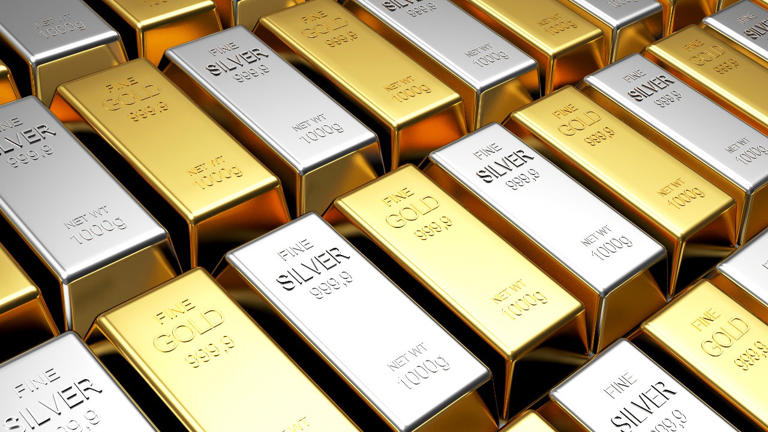When it comes to safeguarding your wealth and navigating turbulent economic landscapes, precious metals like gold and silver often take center stage. Both boast rich histories as reliable stores of value, but for the discerning investor, a crucial question arises: which metal reigns supreme as an investment option?

This article delves into the unique characteristics of gold and silver, while analyzing their historical performance, and equips you with the knowledge to make informed investment decisions.
Table of Contents
Allure of Gold: A Timeless Treasure
Gold has captivated humanity for millennia. Its inherent beauty, scarcity, and resistance to corrosion have cemented its status as a symbol of wealth and prestige. Here’s a closer look at the factors that make gold an attractive investment:
- Hedge Against Inflation: Throughout history, gold has exhibited a remarkable ability to retain its value even as currencies fluctuate. During periods of inflation, when the purchasing power of traditional currencies erodes, gold prices often rise, acting as a natural hedge against inflation.
- Safe Haven Asset: Gold’s reputation as a safe haven asset is unparalleled. During economic turmoil, political unrest, or global crises, investors often flock to gold, driving up its price. This characteristic makes gold a valuable tool for portfolio diversification, offering stability and mitigating risk.
- High Liquidity: Gold enjoys exceptional liquidity, meaning it can be easily bought and sold in the market. This translates to readily available cash when needed, unlike some other investment options.
- Tangible Asset: Unlike stocks or bonds, gold is a tangible asset. You can physically hold your investment in the form of coins, bars, or jewelry. This tangibility offers a sense of security and control for some investors.
Silver’s Allure: A Versatile Investment
Often overshadowed by its golden counterpart, silver offers a distinct set of investment advantages:
- Industrial Applications: Beyond its monetary value, silver possesses significant industrial applications. It is a vital component in electronics, solar panels, and medical equipment. This dual role as a precious metal and an industrial commodity can influence its price movements.
- Lower Price Point: Compared to gold, silver boasts a lower price tag, making it a more accessible investment option for a wider range of investors. This affordability allows for potentially larger volume purchases, which can magnify returns.
- Higher Growth Potential: Historically, silver has exhibited greater price volatility than gold. This volatility translates to a higher potential for significant returns, particularly during periods of economic growth or rising industrial demand.
- Diversification Opportunity: Including both gold and silver in your portfolio offers diversification benefits. Their price movements are not always perfectly correlated, meaning that when one metal dips, the other might rise, offering a hedge against market fluctuations.
The Historical Scorecard: A Tale of Two Metals
Looking at historical performance, gold has traditionally been the more stable investment. Its price has shown a steady upward trend over time, with occasional corrections. Silver, on the other hand, exhibits more volatility, experiencing periods of significant price swings.
Here’s a simplified breakdown:
- Gold: Offers a steadier, long-term growth trajectory with a strong track record of inflation protection.
- Silver: Presents a potentially higher growth potential due to its dual role as a precious metal and an industrial commodity, but with greater price volatility.
Remember: Past performance is not necessarily indicative of future results.
Choosing Your Champion: Aligning Investment Goals with Metal Strengths
The ideal investment for you depends on your individual circumstances, risk tolerance, and investment goals. Here’s a breakdown to help you decide:
- Seeking Stability and Inflation Protection: If long-term stability and a hedge against inflation are your priorities, gold might be the more suitable choice.
- Open to Higher Risk for Potential High Returns: Investors comfortable with a more volatile market and seeking potentially higher returns might find silver appealing.
- Building a Diversified Portfolio: For a well-rounded portfolio, consider including both gold and silver. Their price movements don’t always move in tandem, offering a layer of protection against market downturns.
Additional Factors to Consider:
- Investment Horizon: Are you investing for the short-term or the long-term? Gold is generally considered a better long-term investment, while silver might be suitable for both short-term and long-term strategies depending on market conditions.
- Risk Tolerance: How comfortable are you with market fluctuations? Silver’s higher volatility might not be suitable for risk-averse investors.
- Investment Costs: Factor in the costs associated with buying, storing, and selling each metal. Physical silver might
Also read: How Gold was performing Last year